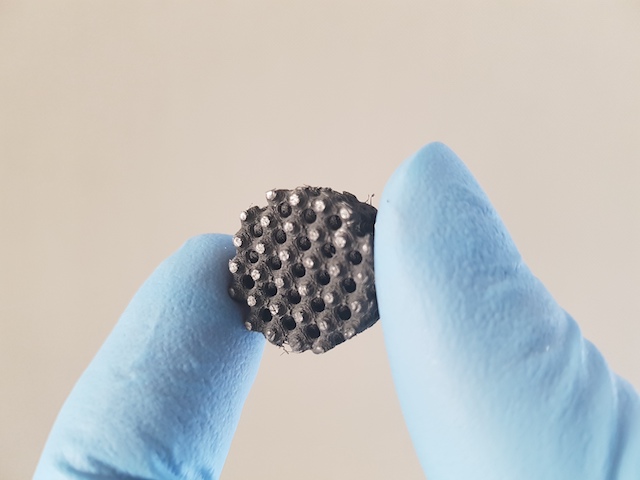
This waffled, greyish thing may not look like much but scientists are hopeful that it can be useful as a health sensor in athletic shoes and elsewhere. A March 6, 2020 news item on Nanowerk describes the work in more detail (Note: Links have been removed),
Researchers have utilized 3D printing and nanotechnology to create a durable, flexible sensor for wearable devices to monitor everything from vital signs to athletic performance (ACS Nano, “3D-Printed Ultra-Robust Surface-Doped Porous Silicone Sensors for Wearable Biomonitoring”).
The new technology, developed by engineers at the University of Waterloo [Ontario, Canada], combines silicone rubber with ultra-thin layers of graphene in a material ideal for making wristbands or insoles in running shoes.
A March 6, 2020 University of Waterloo news release, which originated the news item, delves further,
When that rubber material bends or moves, electrical signals are created by the highly conductive, nanoscale graphene embedded within its engineered honeycomb structure.
“Silicone gives us the flexibility and durability required for biomonitoring applications, and the added, embedded graphene makes it an effective sensor,” said Ehsan Toyserkani, research director at the Multi-Scale Additive Manufacturing (MSAM) Lab at Waterloo. “It’s all together in a single part.”
Fabricating a silicone rubber structure with such complex internal features is only possible using state-of-the-art 3D printing – also known as additive manufacturing – equipment and processes.
The rubber-graphene material is extremely flexible and durable in addition to highly conductive.
“It can be used in the harshest environments, in extreme temperatures and humidity,” said Elham Davoodi, an engineering PhD student at Waterloo who led the project. “It could even withstand being washed with your laundry.”
The material and the 3D printing process enable custom-made devices to precisely fit the body shapes of users, while also improving comfort compared to existing wearable devices and reducing manufacturing costs due to simplicity.
Toyserkani, a professor of mechanical and mechatronics engineering, said the rubber-graphene sensor can be paired with electronic components to make wearable devices that record heart and breathing rates, register the forces exerted when athletes run, allow doctors to remotely monitor patients and numerous other potential applications.
Researchers from the University of California, Los Angeles and the University of British Columbia collaborated on the project.
Here’s a link to and a citation for the paper,
3D-Printed Ultra-Robust Surface-Doped Porous Silicone Sensors for Wearable Biomonitoring by Elham Davoodi, Hossein Montazerian, Reihaneh Haghniaz, Armin Rashidi, Samad Ahadian, Amir Sheikhi, Jun Chen, Ali Khademhosseini, Abbas S. Milani, Mina Hoorfar, Ehsan Toyserkani. ACS Nano 2020, 14, 2, 1520-1532 DOI: https://doi.org/10.1021/acsnano.9b06283 Publication Date: January 6, 2020 Copyright © 2020 American Chemical Society
This paper is behind a paywall.